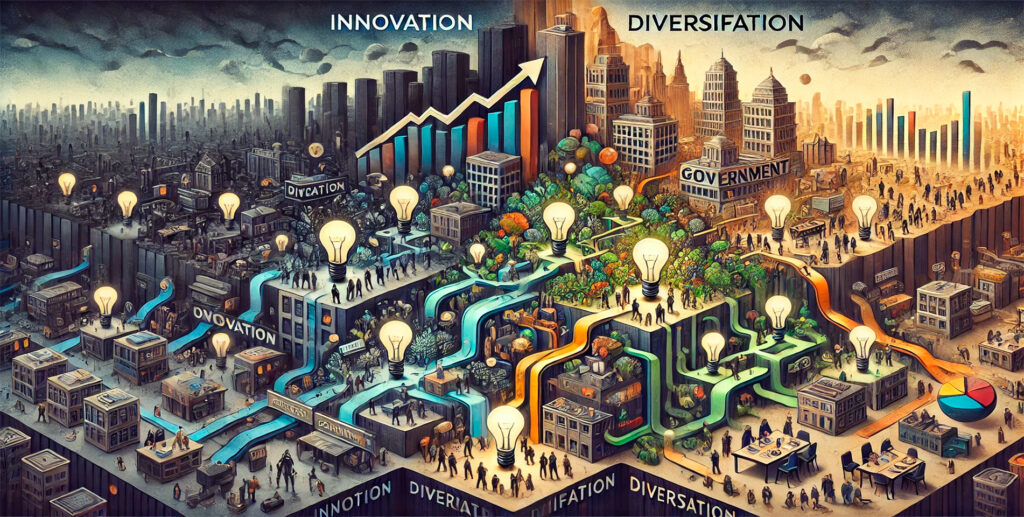Preventing Economic Decline: Tackling Oversaturation in Services Markets

In a highly competitive services market, oversaturation occurs when there are too many businesses offering the same services, leading to reduced profitability, increased competition, and market stagnation. While competition is vital for a healthy economy, oversaturation can push businesses toward financial strain, driving many to close down. The economic consequences of oversaturation can be severe, including reduced innovation, lower profitability across industries, and an overall slowdown in economic growth.
This article explores the potential economic fallout of an oversaturated services market and provides strategies for businesses and governments to avoid a market collapse.
Understanding Market Oversaturation
Market oversaturation happens when the supply of services exceeds the demand, leading to an abundance of similar offerings that outpace customer needs. In such environments, businesses must lower prices, reduce profit margins, and compete aggressively just to stay afloat. While this can benefit consumers in the short term, the long-term effects can be detrimental, causing widespread financial instability for businesses and the economy as a whole.
As more companies enter the market, the surplus of services can result in diminishing returns. The market becomes fragmented, and differentiation between providers becomes increasingly difficult, leaving little room for innovation or meaningful growth.
1. Increased Competition and Shrinking Profit Margins
In an oversaturated market, businesses often resort to price competition in an attempt to attract customers. This leads to shrinking profit margins, making it difficult for companies to cover operational costs or invest in further development. Smaller businesses are particularly vulnerable, as they may lack the financial resilience to survive prolonged periods of low profitability.
Consequences of price competition:
- Reduced profitability: Constant price-cutting erodes profit margins, making it challenging for businesses to remain financially viable.
- Increased financial strain on small businesses: Without the capital reserves of larger corporations, small businesses may struggle to compete and face closure.
2. Stagnation in Innovation
As businesses focus on survival rather than growth, innovation tends to suffer. When profit margins are squeezed and resources are limited, companies may be hesitant to invest in research and development (R&D) or new product offerings. This lack of innovation can stifle industry growth, reducing the overall competitiveness of the market.
How oversaturation stifles innovation:
- Limited R&D investment: With businesses focused on maintaining profitability, there is less incentive to explore new technologies or services.
- Reduced differentiation: Without innovation, companies struggle to differentiate themselves from competitors, leading to a homogenous market.

Economic Fallout of an Oversaturated Market
The economic consequences of oversaturation extend beyond individual businesses and can have far-reaching impacts on the broader economy. When businesses are unable to survive in an oversaturated market, widespread closures occur, leading to job losses, reduced consumer spending, and an overall economic downturn.
1. Business Closures and Job Losses
As profit margins decline and competition intensifies, many businesses are forced to close their doors. This not only affects the businesses themselves but also has a cascading effect on the workforce. Job losses occur as businesses downsize or shut down entirely, leading to reduced household income and decreased consumer spending. In sectors that rely heavily on service providers, such as retail, hospitality, or health care, widespread closures can lead to significant economic disruption.
Impact of business closures on the economy:
- Job losses: As businesses close, workers are laid off, leading to higher unemployment rates and reduced consumer confidence.
- Lower consumer spending: Job losses and reduced income result in decreased spending power, which negatively impacts the economy.
2. Decreased Economic Growth
An oversaturated market can also slow economic growth. As businesses focus on maintaining market share rather than expanding, fewer investments are made in new technologies or markets. Additionally, with fewer businesses thriving and more failing, overall economic output declines. The resulting economic stagnation can take years to recover from, as reduced business activity and consumer spending create a cycle of slow growth.
How oversaturation slows economic growth:
- Reduced industry expansion: A lack of innovation and investment leads to slower industry growth, limiting job creation and economic progress.
- Slower GDP growth: As businesses fail and consumer spending declines, the overall gross domestic product (GDP) growth rate slows.
3. Loss of Consumer Confidence
When businesses close and economic growth slows, consumer confidence is often shaken. A loss of confidence in the economy can lead to reduced spending, as consumers become more cautious about their financial security. This further compounds the economic fallout, as lower consumer spending means less revenue for businesses, exacerbating the challenges faced in an oversaturated market.
The role of consumer confidence in market health:
- Decreased spending: Consumers may cut back on discretionary spending when they feel uncertain about the economy, further slowing business activity.
- Increased savings: Instead of spending, consumers may choose to save more, which limits the flow of money through the economy.

Strategies to Prevent Market Collapse
While the economic fallout of an oversaturated market can be severe, there are strategies that businesses and governments can adopt to prevent market collapse. By fostering innovation, encouraging diversification, and promoting market regulation, it is possible to mitigate the risks of oversaturation and support sustainable market growth.
1. Encouraging Innovation and Differentiation
One of the most effective ways to avoid market collapse is by encouraging businesses to focus on innovation and differentiation. By offering unique products or services, companies can reduce the need for aggressive price competition and build customer loyalty. Governments can support innovation by providing grants or tax incentives for R&D, helping businesses develop new technologies and expand into untapped markets.
How innovation prevents market collapse:
- Unique offerings: By differentiating their services, businesses can attract loyal customers and avoid the downward spiral of price competition.
- Government support: Financial incentives for R&D can encourage businesses to innovate and grow, ensuring the market remains competitive and dynamic.
2. Diversifying Service Offerings
Diversification is another key strategy for preventing oversaturation. Rather than relying on a single product or service, businesses can expand their offerings to cater to different customer needs or enter new markets. This not only reduces their reliance on an oversaturated market but also provides additional revenue streams that can sustain the business during periods of low demand.
Benefits of diversification in oversaturated markets:
- Reduced reliance on one market: By offering a broader range of services, businesses can maintain profitability even when one segment of the market is oversaturated.
- New revenue streams: Expanding into new markets or introducing complementary services helps businesses tap into additional revenue opportunities.
3. Promoting Government Regulation and Market Oversight
Government regulation and market oversight can play an important role in preventing market oversaturation and collapse. Policies that limit the number of new entrants in oversaturated sectors can help reduce unnecessary competition and maintain a healthier balance between supply and demand. Additionally, governments can promote fair competition by enforcing antitrust laws, ensuring that no single company monopolizes the market.
How government regulation supports market health:
- Controlling market entry: Limiting the number of new businesses in an oversaturated market prevents the imbalance of supply and demand from worsening.
- Ensuring fair competition: Antitrust laws prevent monopolistic practices, ensuring that smaller businesses have an opportunity to compete and grow.
Long-Term Solutions for Sustainable Market Growth
In addition to short-term strategies, businesses and governments should focus on long-term solutions to ensure sustainable market growth. This includes fostering a culture of innovation, supporting small businesses, and promoting education and training for workers to adapt to new industries.
1. Supporting Small Businesses and Startups
Small businesses and startups are often the drivers of innovation in an economy. Governments can support these businesses through financial aid, tax incentives, and grants that enable them to grow and compete in a crowded market. By nurturing the growth of small businesses, governments can help maintain a healthy balance in the market and promote economic diversity.
How supporting small businesses fosters growth:
- Access to funding: Financial support allows small businesses to invest in growth and innovation, helping them compete in the market.
- Encouraging diversity: Promoting the growth of small businesses ensures a diverse range of products and services, reducing the risk of oversaturation in any one sector.
2. Promoting Workforce Training and Education
As markets evolve, so must the workforce. Governments and businesses can collaborate to offer education and training programs that prepare workers for new industries or help them develop skills in emerging technologies. A well-educated workforce is essential for driving innovation and ensuring that businesses can adapt to changing market conditions.
Benefits of workforce training:
- Adapting to new industries: Training programs help workers transition to growing sectors, reducing unemployment and maintaining economic stability.
- Boosting productivity: A skilled workforce can enhance productivity and innovation, supporting long-term economic growth.
Conclusion
Market oversaturation can lead to significant economic fallout, including reduced profitability, job losses, and slowed economic growth. However, by encouraging innovation, promoting diversification, and supporting small businesses, governments and industries can mitigate the risks of oversaturation and ensure sustainable market growth. With the right strategies in place, it is possible to avoid a market collapse and maintain a healthy, competitive economy.


